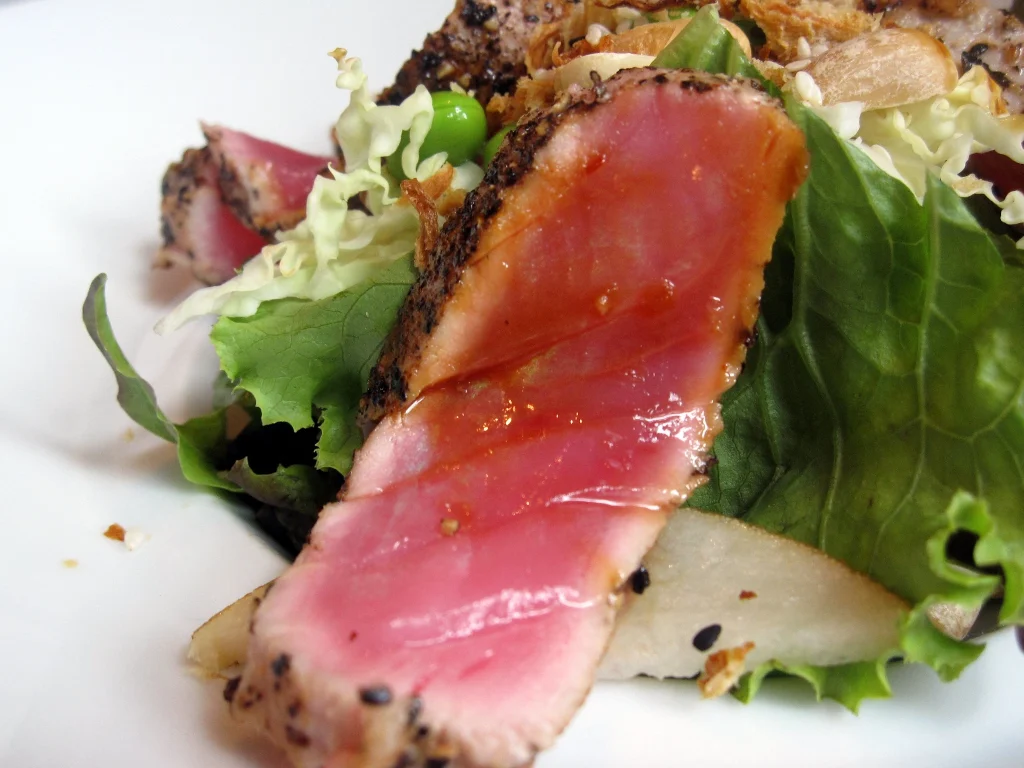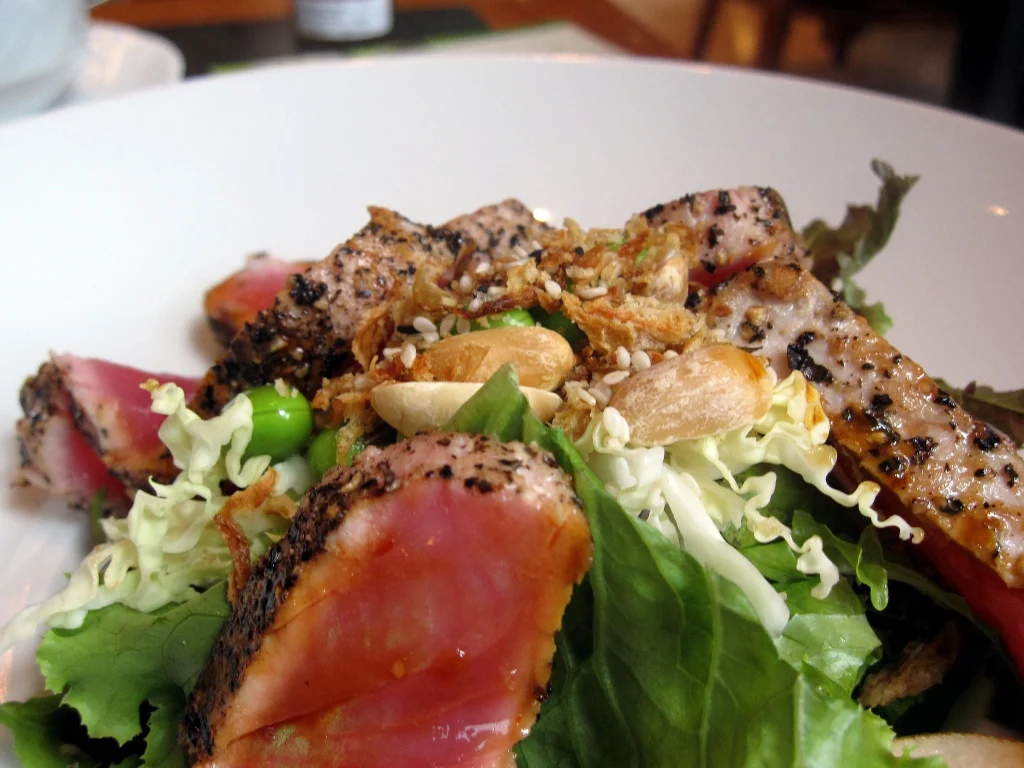The Best Fluffy Pancakes recipe you will fall in love with. Full of tips and tricks to help you make the best pancakes.
Ahi tuna is a versatile and flavorful fish that’s often served raw or lightly cooked. While searing is a popular method, many people seek the best ways to prepare ahi tuna without searing to preserve its tender texture and natural taste. In addition to its delicate flavor, ahi tuna is rich in omega-3 fatty acids, which are known for their heart health benefits (source: NIH). Whether you prefer raw dishes like sushi and poke or gently cooked methods like poaching and baking, there are plenty of delicious options to explore.
Ahi tuna, also known as yellowfin tuna, is a prized fish known for its rich, buttery texture and mild flavor. Commonly used in sushi, sashimi, and poke bowls, this high-quality seafood is a favorite among seafood lovers worldwide. While searing is one of the most popular ways to prepare ahi tuna, many people prefer alternative methods that preserve its delicate texture and unique taste.
Some opt for non-seared preparations due to personal dietary preferences, health considerations, or simply to enjoy the tuna in its most natural form. Raw or gently cooked ahi tuna offers a melt-in-your-mouth experience, allowing the freshness of the fish to shine. Additionally, alternative cooking methods like poaching or baking can enhance its flavor while maintaining moisture and tenderness.
Ahi tuna’s versatility makes it a staple in various cuisines, from Hawaiian poke bowls to Japanese sashimi and Mediterranean-style tuna tartare. Whether served raw, cured, or lightly cooked, ahi tuna provides endless possibilities for delicious and creative dishes. In this guide, we’ll explore the best ways to prepare ahi tuna without searing, ensuring you can enjoy its exceptional quality to the fullest.
Choosing the Best Ahi Tuna for Non-Seared Recipes
When preparing ahi tuna without searing, selecting high-quality fish is crucial to ensure both safety and flavor. Since many non-seared preparations involve eating the tuna raw or lightly cooked, choosing the freshest and best-quality tuna is essential.

The Importance of Sushi-Grade Tuna for Raw Preparations
If you plan to enjoy your ahi tuna raw in sushi, poke, or ceviche, it’s important to purchase sushi-grade or sashimi-grade tuna. This classification means the fish has been handled and frozen according to FDA guidelines to reduce the risk of parasites. Keep in mind that “sushi-grade” is not a regulated term, so it’s always best to buy from a trusted source.
How to Select Fresh, High-Quality Tuna
To get the best ahi tuna, use your senses:
- Color: Fresh ahi tuna should have a vibrant, deep red or pink hue. Avoid fish that looks brown or dull, as this indicates oxidation and age.
- Smell: High-quality tuna should have a mild, ocean-like scent. If it smells overly fishy or sour, it’s past its prime.
- Texture: The flesh should be firm and slightly springy when pressed. If it feels mushy or slimy, it’s not fresh.
Where to Buy Premium Ahi Tuna
Finding the best ahi tuna requires knowing where to shop. Here are some of the best sources:
- Fish Markets: Local seafood markets often have the freshest selection, and you can ask the fishmonger about the sourcing and quality.
- Grocery Stores: Some high-end grocery stores, such as Whole Foods or specialty markets, carry sushi-grade ahi tuna. Look for vacuum-sealed or freshly cut pieces.
- Online Seafood Retailers: Many reputable online retailers ship high-quality, sushi-grade tuna directly to your home. Look for suppliers that specialize in wild-caught or responsibly farmed tuna with overnight shipping options.
By choosing the best ahi tuna, you ensure a safe and flavorful dining experience, whether you’re making sushi, poke, ceviche, or gently cooked dishes.
Raw and Cured Ahi Tuna: The Best Ways to Enjoy It Without Searing
Ahi tuna is prized for its smooth texture and mild, buttery flavor, making it perfect for raw and cured preparations. Whether you’re slicing it for sushi, tossing it into a poke bowl, or curing it with citrus for ceviche, these methods highlight the freshness of the fish while enhancing its natural taste.
How to Make Sushi and Sashimi with Ahi Tuna
Sushi and sashimi are some of the most elegant ways to enjoy ahi tuna. Here’s how to prepare them:
- Sashimi:
- Use a sharp knife to slice the tuna into thin, even pieces (about ¼ inch thick).
- Serve with soy sauce, wasabi, and pickled ginger for a traditional experience.
- Nigiri Sushi:
- Form small, oval-shaped mounds of seasoned sushi rice.
- Place a slice of ahi tuna on top, optionally securing it with a thin strip of nori (seaweed).
- Brush lightly with soy sauce or drizzle with a touch of yuzu or ponzu sauce.
- Tuna Rolls (Maki):
- Lay a sheet of nori on a bamboo mat, spread sushi rice evenly, and add a strip of ahi tuna.
- Roll tightly, slice into bite-sized pieces, and serve with soy sauce and wasabi.
Classic Poke Bowl Recipe with Seasoning Tips
Hawaiian poke bowls are a fresh and flavorful way to enjoy raw ahi tuna. Here’s a simple yet delicious recipe:
Ingredients:
- 1 lb sushi-grade ahi tuna, diced into bite-sized cubes
- 2 tbsp soy sauce
- 1 tbsp sesame oil
- 1 tsp rice vinegar
- 1 tsp honey or brown sugar
- ½ tsp red pepper flakes or sriracha (optional)
- 1 tbsp chopped green onions
- 1 tbsp sesame seeds
- ½ avocado, diced (optional)
Instructions:
- In a bowl, whisk together soy sauce, sesame oil, rice vinegar, and honey.
- Add diced tuna and gently toss to coat.
- Mix in green onions, sesame seeds, and red pepper flakes.
- Let it marinate for 10–15 minutes in the fridge.
- Serve over steamed rice or mixed greens, topped with avocado and additional sesame seeds.
Seasoning Tip: Adjust flavors by adding a splash of ponzu sauce for citrusy notes or a bit of gochujang (Korean chili paste) for extra heat.
How to Prepare a Zesty Ahi Tuna Ceviche
Ceviche is a bright, refreshing dish that uses citrus juice to “cook” the fish without heat.
Ingredients:
- 1 lb sushi-grade ahi tuna, diced
- ½ cup fresh lime juice
- ¼ cup fresh lemon juice
- ¼ cup red onion, finely chopped
- 1 jalapeño, minced (optional for spice)
- ½ cup diced cucumber
- ½ cup diced mango or pineapple (for sweetness)
- ¼ cup chopped cilantro
- Salt and pepper to taste
Instructions:
- In a glass bowl, combine tuna, lime juice, and lemon juice. Let sit for 10–15 minutes.
- Stir in red onion, jalapeño, cucumber, and mango.
- Season with salt, pepper, and fresh cilantro.
- Serve chilled with tortilla chips or on a bed of lettuce.
Flavor Tip: For a Peruvian-style ceviche, add a dash of aji amarillo (yellow chili paste) and serve with sweet potato slices.
These raw and cured preparations allow you to enjoy ahi tuna in its purest, freshest form, bursting with vibrant flavors and delicate textures.
Cooked Ahi Tuna Without Searing – Poaching, Baking, and Grilling

While ahi tuna is often enjoyed raw or lightly seared, there are several ways to cook it gently without losing its delicate texture and flavor. Poaching, baking, and grilling at lower temperatures allow the tuna to remain tender and moist while absorbing delicious seasonings and marinades.
Gently Poaching Ahi Tuna in Flavorful Broths
Poaching is a great technique to keep ahi tuna tender and infuse it with flavor. By simmering the fish in a flavorful broth, you prevent it from drying out while enhancing its natural taste.
How to Poach Ahi Tuna:
- Fill a saucepan with enough liquid to submerge the tuna. Use a flavorful poaching liquid, such as:
- Water or vegetable broth with lemon slices and garlic
- Coconut milk with ginger and lime for a tropical twist
- Soy sauce and dashi broth for an umami-rich taste
- Bring the liquid to a low simmer (about 160–180°F, not boiling).
- Gently place the ahi tuna in the broth and cook for 3–5 minutes, depending on thickness.
- Remove the tuna and let it rest before serving.
Serving Idea: Serve poached ahi tuna over rice, drizzled with the poaching liquid, or flake it into salads and grain bowls.
Baking Methods to Retain Moisture and Flavor
Baking ahi tuna is an easy way to cook it gently while locking in moisture. To avoid drying out the fish, use a moderate oven temperature and add moisture with a marinade or foil wrap.
How to Bake Ahi Tuna:
- Preheat the oven to 375°F (190°C).
- Place the tuna steaks in a baking dish and brush with a marinade (such as olive oil, lemon juice, soy sauce, or miso glaze).
- Cover with foil to trap moisture.
- Bake for 10–12 minutes, depending on thickness, until the tuna is just cooked through but still tender.
Flavor Tip: For extra juiciness, bake the tuna in parchment paper with herbs, cherry tomatoes, and a drizzle of white wine.
Grilling Techniques That Don’t Involve High-Heat Searing
Grilling ahi tuna without high-heat searing requires a gentler approach, ensuring the fish remains moist and flaky rather than charred.
How to Grill Ahi Tuna Without Searing:
- Use indirect heat: Instead of placing the tuna directly over flames, cook it on the cooler side of the grill.
- Marinate for moisture: A marinade with olive oil, citrus, and soy sauce helps prevent dryness.
- Wrap in foil or banana leaves: This helps lock in juices and infuse additional flavor.
- Cook at medium-low heat (around 300°F–350°F) for 8–10 minutes, flipping halfway through.
Serving Idea: Serve grilled ahi tuna over a bed of roasted vegetables with a drizzle of lemon-dill sauce.
By using these gentle cooking techniques, you can enjoy ahi tuna in a variety of delicious ways while preserving its delicate texture and rich flavor.
Serving Ahi Tuna Without Searing – The Best Pairings and Sauces
Once you’ve prepared your ahi tuna—whether raw, cured, or gently cooked—the right sauces, side dishes, and beverage pairings can take your dish to the next level. Carefully chosen flavors enhance the tuna’s delicate taste while creating a well-balanced meal.
Best Sauces, Marinades, and Garnishes
Ahi tuna’s mild, buttery texture pairs well with a variety of sauces and marinades that add depth and brightness to the dish.
- Soy-Based Sauces:
- Ponzu sauce (citrusy and umami-rich)
- Teriyaki glaze (sweet and savory)
- Ginger-soy dressing (light and aromatic)
- Creamy Sauces:
- Spicy mayo (sriracha + mayo + lime juice)
- Wasabi aioli (mayo + wasabi + lemon juice)
- Avocado-cilantro crema (avocado + yogurt + lime + cilantro)
- Herb and Citrus-Based Marinades:
- Olive oil, lemon, garlic, and dill
- Miso, sesame oil, and rice vinegar
- Coconut milk, lime, and Thai basil
- Garnishes:
- Sesame seeds or furikake (for added crunch)
- Microgreens or seaweed flakes (for a fresh bite)
- Pickled ginger or wasabi (for traditional sushi-style dishes)
Ideal Side Dishes for Raw and Cooked Ahi Tuna
The best side dishes complement the flavors of the tuna while adding texture and variety to the meal.
- For Raw and Cured Ahi Tuna (Sushi, Poke, Ceviche):
- Steamed Jasmine Rice or Sushi Rice – A neutral base that absorbs flavors.
- Seaweed Salad – Light, slightly tangy, and packed with umami.
- Crispy Wontons or Tortilla Chips – Adds a satisfying crunch, especially for poke or ceviche.
- Pickled Vegetables – Brightens up the dish with acidity.
- For Cooked Ahi Tuna (Poached, Baked, Grilled):
- Garlic Butter Asparagus or Roasted Vegetables – Brings out the umami in the fish.
- Quinoa or Brown Rice Pilaf – A hearty, nutritious base.
- Coconut Rice – Adds a touch of sweetness, perfect for tropical flavors.
- Sautéed Spinach with Garlic – A simple, flavorful side.
Wine and Beverage Pairings to Complement Ahi Tuna
The right drink pairing enhances the flavors of ahi tuna and balances the dish’s seasoning.
- For Raw and Lightly Seasoned Tuna:
- Sauvignon Blanc – Crisp and citrusy, great for sushi and ceviche.
- Chablis (Unoaked Chardonnay) – Light minerality pairs well with raw tuna.
- Dry Rosé – Refreshing and slightly fruity, complements poke bowls.
- For Cooked Tuna Dishes:
- Pinot Noir – A light red wine that won’t overpower the tuna.
- Viognier or Chardonnay – Richer white wines that balance baked or poached preparations.
- Sake – Traditional and well-matched with Japanese-inspired flavors.
- Non-Alcoholic Pairings:
- Green Tea or Jasmine Tea – Cleanses the palate with a fresh finish.
- Ginger-Lemon Sparkling Water – Adds brightness without overpowering flavors.
- Coconut Water – A tropical match for poke or coconut-infused tuna dishes.
With the right sauces, sides, and drinks, you can create a perfectly balanced meal that highlights the best qualities of ahi tuna. Whether you’re serving it raw, cured, or gently cooked, these pairings will elevate your dish to gourmet status!
If you enjoy fresh seafood, you might also love our : The Best Seafood Spaghetti Recipe for Pasta Lovers






Each sentence in this piece feels like it was carefully sculpted, revealing new layers the more you read.
Each sentence is like a puzzle piece fitting perfectly into a larger picture of understanding.